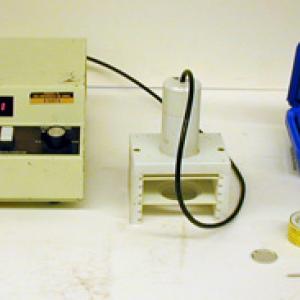College of Liberal Arts & Sciences
7D10.20 - Half Life - Isotope Generator
Force about 1 ml of the eluting solution through the generator and collect 7 or 8 drops of the passed solution in one of the planchets. Immediately place disk in the tube holder and start the counter. Counting will be done for 10 thirty-second intervals for a total of 5 minutes. The half life of Barium 137M is 2.55 minutes (2 min, 33 sec). With a 661.6 keV gamma ray being emitted.
NOTE: Background count should be determined before sample counting begins.
- Paul Hewitt, "Figuring Physics", TPT, Vol. 62, #3, March 2024, p. 222.
- Roeland Boot, "Uranium Glass: A Glowing Alternative to Conventional Sources of Radioactivity", TPT, Vol. 55, #2, Feb. 2017, p. 76.
- Fred Myers, "Temporary Personal Radioactivity", TPT, Vol. 50, #8, Nov. 2012, p. 499.
- "Editor's Note", TPT, Vol. 47, #5, May 2009, p. 261.
- Terrence Toepker, "Toepker's Response: To Err is Human", TPT, Vol. 47, #5, May 2009, p. 261.
- Donald W. Olson and Joseph C. Herbert, "Taking Probability to Heart", TPT, Vol. 47, #5, May 2009, p. 261.
- Christopher G. Deacon, "A Background to Background Radiation", TPT, Vol. 41, #2, Feb. 2003, p. 78.
- Terrence Toepker, "More Physics with Cardiolite®", TPT, Vol. 47, #3, Mar. 2009, p. 132.
- Kenneth Jesse, "Biological Half-Life of Cardiolite®", TPT, Vol. 46, #9, Dec. 2008, p. 522.
- Art Hobson, "Hands-On Simulation", TPT, Vol. 42, #3, Mar. 2004, p. 132.
- Kenneth E. Jesse, "Computer Simulation of Radioactive Decay", TPT, Vol. 41, #9, Dec. 2003, p. 542.
- Stephen J. Fairman, Joseph A. Johnson, and Thomas A. Walkiewicz, "Fluid Flow with Logger Pro", TPT, Vol. 41, #6, Sept. 2003, p. 345.
- Alfred D. McKee and Paul Stengel, "The Minigenerator, An Evaluation", TPT, Vol. 8, #8, Nov. 1970, p. 463.
- Herbert H. Gottlieb, "Half-life Using Short-Lived Radioisotopes", TPT, Vol. 6, #3, March 1968, p. 128.
- Richard O. Thomas, "A Device for Demonstrating Half-Thickness of Shielding Materials", TPT, Vol. 4, #2, Feb. 1966, p. 77, also A Potpourri of Physics Teaching Ideas - Odds and Ends, p. 316.
- B. E. Taylor, "An Automated Short Half-Life Experiment", AJP, Vol. 57, #11, Nov. 1989, p. 1051.
- J. R. Cussenot, M. Fabry, "Undergraduate Experiment: Half-Lifes of Thorium 232 and Radon 220, AJP, Vol. 48, # 9, Sept. 1980, p. 776.
- S. K. Chakarvarti, K. K. Nagpaul, "Simple Experimental Method for Determination of the Half-Life of 238U Using Solid-State Track Detectors", AJP, Vol. 47, #10, Oct. 1979, p. 920.
- K. Gopal, H. Sanjeevaiah, B. Sanjeevaiah, "A Laboratory Experiment for Determining the Partial Half-Life 40K For Beta Emission", AJP, Vol. 40, #5, May 1972, p. 721.
- W. H. Snedegar and A. R. Exton, "Comment on 'Radioactive Half-Life Determination with an Isotope Generator' ", AJP, Vol. 39, #10, Oct. 1971, p. 1282.
- M. K. Ramaswamy, "Reply to W. H. Snedegar and A. R. Exton", AJP, Vol. 39, #10, Oct. 1971, p. 1282.
- Charles R. Rhyner, "More on Laboratory Isotope Generators", AJP, Vol. 39, #10, Oct. 1971, p. 1274.
- J. M. Oottukulam and M. K. Ramaswamy, "Radioactive Half-Life Determination with an Isotope Generator", AJP, Vol. 39, #2, Feb. 1971, p. 221.
- W. Bolton, "34. The Half-Life of a Thorium Isotope(90Th232)", Book 3. Atomic Physics, Physics Experiments and Projects, 1968, p. 75 - 76.
- W. Bolton, "24. Randomness of Disintegration", Book 3. Atomic Physics, Physics Experiments and Projects, 1968, p. 55 - 56.
- W. Bolton, "21. Limitations of the Scaler", Book 3. Atomic Physics, Physics Experiments and Projects, 1968, p. 49 - 50.
- W. Bolton, "20. The Scaler", Book 3. Atomic Physics, Physics Experiments and Projects, 1968, p. 47 - 48.
Disclaimer: These demonstrations are provided only for illustrative use by persons affiliated with The University of Iowa and only under the direction of a trained instructor or physicist. The University of Iowa is not responsible for demonstrations performed by those using their own equipment or who choose to use this reference material for their own purpose. The demonstrations included here are within the public domain and can be found in materials contained in libraries, bookstores, and through electronic sources. Performing all or any portion of any of these demonstrations, with or without revisions not depicted here entails inherent risks. These risks include, without limitation, bodily injury (and possibly death), including risks to health that may be temporary or permanent and that may exacerbate a pre-existing medical condition; and property loss or damage. Anyone performing any part of these demonstrations, even with revisions, knowingly and voluntarily assumes all risks associated with them.

